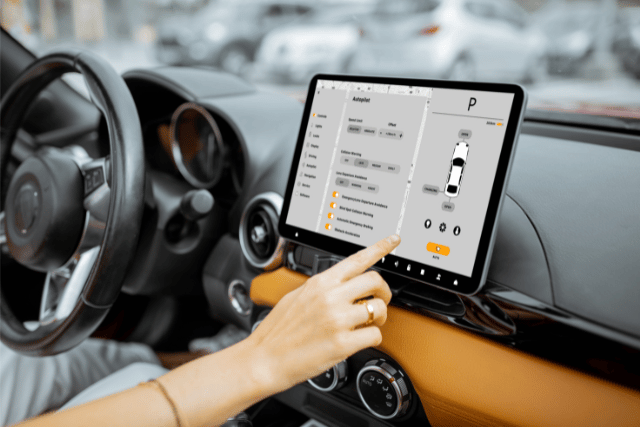Rather than ‘death’ and ‘taxes,’ the most certain thing in life might be advertisements.
In 1845 the United States Postal Service created a new rate category for postal mail-delivered marketing materials.
When people hit the roads in cars, billboard ads appeared.
When telephones and fax machines became prevalent, the telemarketing industry was born.
Websites deliver targeted ads to us while we are online.
Cell phones and other mobile devices give us apps and text messages, both of which are vehicles for more ads.
Ads are not only a part of the experience of riding taxis, but also in ride-hailing cars.
Now ads will follow us to the consoles of our own personal vehicles…
There’s been a stir on the internet recently, as a Reddit post went viral where a Jeep’s center console displayed a pop-up ad, which Jeep attributed to a “temporary software glitch.” But it’s not exactly unimaginable to see a future where car makers and marketers take advantage of this new audience opportunity.
Connected cars are the future
More likely than not, a modern car will be “connected,” which is that it is “equipped with internet connectivity and a range of sensors and communication devices that allow it to interact with its surroundings.
These technologies can include GPS navigation, entertainment systems, diagnostic sensors, and communication tools that enable the car to send and receive data.” In other words, our cars are our new mobile devices.
This means that newer vehicles not only are places in which people are a captive audience for static ads, like the advertising placards that the back seats of taxis often sport, but they are becoming a new way for marketers to gather data, customize ads based on context and behavior, and provide just-in-time personalized experiences.
In a way, we are developing a new Internet of Vehicles (IoV) component to the Internet of Things (IoT).
The privacy considerations for connected cars you can’t ignore
Privacy questions follow closely behind the auto industry’s consideration of vehicle-delivered marketing. Moreover, privacy has some special challenges to overcome when applied to vehicles and marketing.
In-vehicle marketing can involve multiple channels
Most modern auto manufacturers provide one or more apps through which users can interact with the auto company, their vehicles, and even third parties. Most also offer web-based interfaces, and of course there are the vehicle consoles themselves. These technologies are vastly different from one another, but automakers must be able to manage consent and preferences seamlessly across all these channels to provide the experience that car owners and drivers expect.
Drivers and passengers may not be the owner
When an individual purchases a mobile phone, they typically set up their apps, preferences, and consents. A responsible company can collect these consents and preferences on a one-to-one basis (one person, one phone, one set of consents/preferences), comfortably managing those expectations. However, though one person may set up accounts and give consents for a vehicle, there may be multiple owners, drivers, and certainly passengers.
Each one of these people may have their own, vastly different expectations about targeted advertising. Moreover, when different users of a vehicle share information with the vehicle to facilitate services, like playing music and making phone calls, there is the privacy risk of other vehicle users getting access to that information.
Potential sensitivity of the data
Like mobile devices, connected vehicles can collect and share precise location information. Connected cars can also take photos and videos, inside and outside of vehicles. Vehicles also can collect information that can lead to inferences about driving safety behavior, fault in accidents, and even health and religion based on driving destinations.
How can brands navigate ads and privacy in cars?
To navigate the special challenges of the Vehicle of Things (IoV), car companies and their service providers will have to tackle privacy problems head-on. Though the technologies that enable convenience, safety, and reliability that connected vehicles provide are still evolving, auto OEMs that are considering in-vehicle advertising, especially if those involve third-party ad sales, Privacy by Design and Default must be front and center of marketing strategies for those efforts to be successful.
The following are a few privacy considerations for auto companies to consider related to in-vehicle marketing:
- A consent management model that allows interactions in-vehicle, through apps, and online is essential. Vehicle models, including the technology that allows for connectivity, require a long lead time from planning to rolling out to customers. Customers (and regulators) will expect consistent, compliant consent experiences across multiple channels. This means that a connected vehicle designer will need to plan for flexible in-vehicle technologies that can collect consents, as well as a consent management platform that can integrate with those and other technologies.
- Careful and granular data collection and data use protocols are critical. Given that many connected vehicle services, such as driving assistance, rely on the same data that marketing departments will find useful, it will be important for auto makers considering in-vehicle targeted ads to establish flexible but rigorous information gathering, sharing, and use protocols. After all, a driver who unsubscribes from targeted advertising should be able to do so without interrupting other connected vehicle services. This means that data gathering and uses cannot be an all-or-nothing prospect. Rather, connected vehicles manufacturers must establish thoughtful – and granular – technology and processes related to data collection and use. Furthermore, it may be necessary to recognize different users of a vehicle and capture preferences and consents for everyone.
- Establishing Privacy by Design and Privacy by Default practices help ensure that shared vehicles do not expose one vehicle user’s information to another user or apply one user’s consent to other vehicle users’ experiences. Bearing privacy in mind during the initial stages of vehicle and vehicle ad-tech experience design, combined with establishing the most privacy sensitive choices as the default, will help connected vehicle manufacturers manage the challenge that multiple vehicle users present.
In summary…
Today’s cars are transitioning from simply being a mode of transportation to an extension of our mobile, connected lives. Just as advertisements have followed us into our homes through our computers and mobile devices, there is some evidence that vehicles may soon become the newest landscape for targeted ads.
By planning for cross-channel, granular and consistent consent and preference experiences, taking into consideration the fact that vehicles collect and use the personal information of a variety of individuals – drivers, owners, and passengers – and applying Privacy by Design and Default principles to the connected vehicle experience, auto OEMs can succeed in responsibly monetizing car data while earning customer trust.

Exclusive access to Gartner Market Guide for Consent Management
Central to most privacy laws is the challenge of giving users clarity around — and control over — their personal data. This guide helps security and risk management leaders navigate the market for universal consent and preference management capabilities and make informed, forward-looking decisions.
Download now
